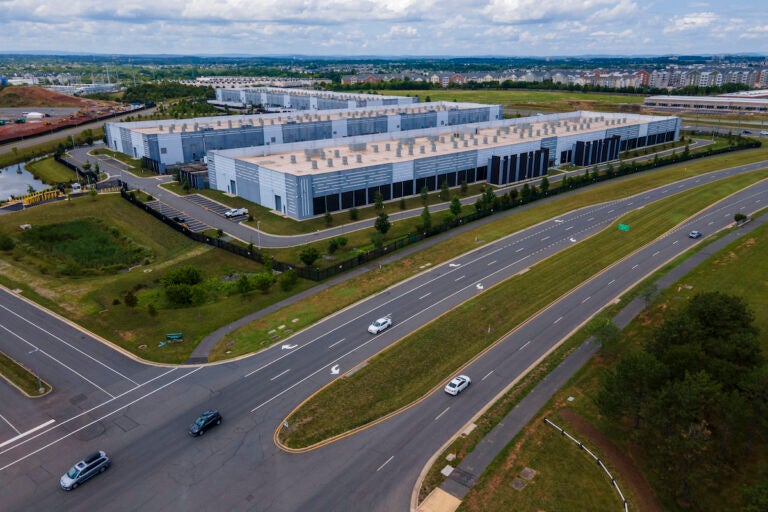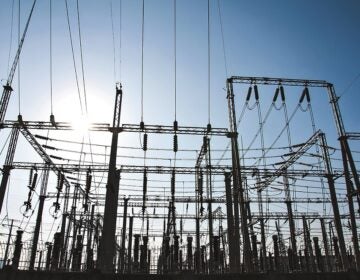Data centers transformed Northern Virginia’s economy, but residents are wary of more expansion
The largest concentration of data centers in the world are in northern Virginia. Amazon estimates that around 70 percent of global internet traffic goes through the area.
Listen 10:40
Data centers are in Ashburn in Loudon County, Virginia, on Sunday, July 16, 2023. The centers house the computer servers and hardware required to support modern internet use, including artificial intelligence. The county is home to the world's largest concentration of data centers. (AP Photo/Ted Shaffrey)
This story is from The Pulse, a weekly health and science podcast.
Find it on Apple Podcasts, Spotify, or wherever you get your podcasts.
More than 10 years ago, Julie and Chris Borneman bought 30 acres of property in northern Virginia that was in pretty bad shape. There was a house, some woodlands, and a lot of junk: old lawn mowers, concrete cylinders, two old cars, and used oil drums.
They cleaned up the property, restored the landscape with native plants, and have since seen a host of local wildlife return, from river otters to herons and bald eagles.
Julie runs a plant nursery on their property, and Chris works for a software company.
But recently, they became concerned about a proposed transmission line that would go through their property and their neighbor’s property.
“It’s taking out all of that really old growth forest to bring in that power line,” said Chris. “ So all that will have to be condemned and removed.”
The new transmission lines would feed the growing demand for electricity from data centers.
Think of data centers as where a lot of the internet lives.
Before cloud computing, a company or organization running a website had their own computer rooms with servers that stored all the text and pictures and videos on those sites.
But more recently, companies like Amazon started hosting all of this information, and the software to support websites, in massive buildings called data centers with row upon row of computers.
The largest concentration of these in the world is not in Silicon Valley or Amazon’s home state of Washington, but in Northern Virginia. Amazon estimates that around 70 percent of global internet traffic goes through northern Virginia.
Amazon is not alone in this business, but their share of the market is twice as big as the next largest company, Microsoft.
Since 2014, Amazon has made more than half of their profits not from their online store, but from their data center business, called Amazon Web Services, or AWS.
Data centers have become a booming industry in northern Virginia, but it’s also become controversial recently. It’s been so controversial that some public hearings about data centers in the region have gone on overnight, or even more than 24 hours, because so many residents signed up to speak, mostly in opposition.
Julie Borneman said she understands that people who use the internet need data centers.
“We all love the internet … if it wasn’t for Google, I don’t know that we would survive anymore and the Amazon guy comes to our house way more frequently than he should.”
But the Bornemans are worried about the environmental impact, and how much more they will have to pay in their power bills for this infrastructure. Data centers use a lot of energy. And unlike a factory or an office building, data centers need that energy constantly, because the internet does not run on regular business hours.
Subscribe to The Pulse
Julie and Chris Borneman signed petitions, wrote to their local officials, put a sign in front of their house, and joined a campaign against putting the power line through their property.
The recent expansion of data centers and associated power infrastructure is unprecedented, according to Julie Bolthouse, director of land use at the Piedmont Environmental Council, a local environmental nonprofit. She has worked at the nonprofit for 15 years.
“Prior to 2021 I had only worked on two or three transmission line proposals … Within the last three years, I’ve been a participant in stakeholder meetings for at least a dozen transmission line proposals,” Bolthouse said. “We’ve never seen this many transmission lines at once.”
The Piedmont Environmental Council has been keeping track of all these data centers and associated power infrastructure.
Bolthouse said the power company and state regulator have been approving many of these projects, but there is not enough public information about how much energy the data centers use, and their impact on air and water quality.
“We need transparency so that we can proactively plan ahead,” said Bolthouse. “Right now, what we’re doing is basically like our utility is handing out blank checks that we, the rate payers, are on the hook for paying for.”
To that, Aaron Ruby, spokesperson for Dominion Energy, the largest utility in Virginia, said, “as a public utility we are the most heavily regulated industry in Virginia.”
He said the state regulator reviews the energy costs to make sure everyone is paying their fair share, and the share of energy costs that households pay for has gone down, whereas the share for data centers has gone up.
He also added that Dominion Energy expects the power demand from data centers to nearly quadruple over the next 15 years.
The demand for power has never gone up by so much, so quickly.
Some of the electricity will come from natural gas plants, but Ruby said most of that will be from renewable energy like wind and solar power.
In a statement, Amazon pointed out that their company has been the world’s largest corporate purchaser of renewable energy for four years, and that 90 percent of the energy the company uses comes from renewable sources.
Local officials say data centers saved their economy during the Great Recession of 2007. Buddy Rizer helped bring data centers to Loudoun County in northern Virginia, as the executive director for economic development for the county for the past 17 years.
He said they brought in data centers because during 2007, the local economy took a big hit when the housing bubble burst. The county lost a third of its tax revenue.
“Data centers have such an inordinate return on investment for a community that there’s nothing else that comes close,” Rizer said. “As an example: for every dollar a data center uses in services in our community. We get $26 back. There’s nothing that comes within $24 of that.”
He said the revenue from data centers helped transform their local economy, so they could invest in their schools and roads. He added that the tax revenue from data centers is almost a third of the county’s budget, and completely funds their operating budget.
But Rizer has also heard the concerns about how quickly the industry is growing in their area.
“When you’re in any job 17 years, in your community, you become your job … especially a fairly public facing job like mine,” Rizer said. “I have a lot of conversations at the grocery store or when I’m filling my car with gas.”
He expects the demand for data centers to continue to grow.
Rizer said cloud computing led to a big wave of data centers, then it was the demand for online services during COVID-19. Now, the big driver of growth is artificial intelligence.
He said data centers actually do not have a lot more room to grow in Loudoun County anymore. The more recent proposals for new data centers have been in the surrounding counties, Maryland, states like Kansas and Mississippi, or other countries, like China, India, Japan, and Malaysia.
WHYY is your source for fact-based, in-depth journalism and information. As a nonprofit organization, we rely on financial support from readers like you. Please give today.







